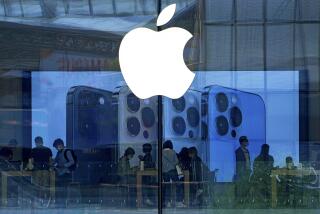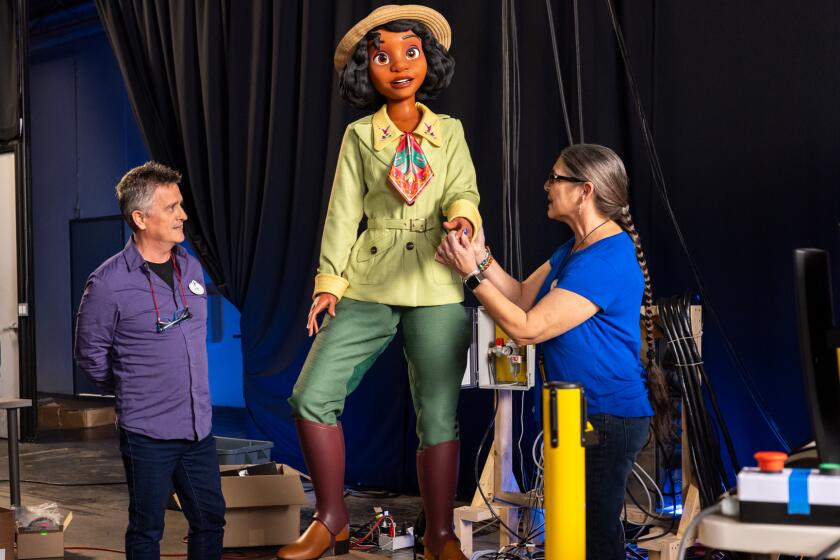How Apple Arcade wants to bust up free-to-play games. And why that’s a good thing
The iPhone and its App Store changed gaming. And not always for the better.
Yet now with Apple Arcade, a game subscription service launching this week, Apple wants to tweak and elevate the conversation surrounding games.
The smartphone, and not the PC or video game console, is the dominating game device of our time. And while not everyone is carrying an Apple product in their pocket, there’s no denying that we associate the likes of “Candy Crush” and “Clash of Clans” — games whose lifetime revenue is estimated to be in the billions — with the iPhone revolution. The mobile market brought many new players to gaming, but it also furthered the belief that games are a disposable art form.
An example: This week, I downloaded “Homescapes,” which mobile analytics firm Sensor Tower currently ranks as one of the top-grossing iPhone games, boasting more than 4 million downloads and $25 million in revenue in its two years of release. Apple’s own editorial team has championed the game, writing that it’s “slightly strange” and “undeniably delightful.” Yet in “Homescapes,” the story is divorced from the gameplay and any extended gaming session results in a prompt to buy coins to keep playing. It’s easy enough to play without spending money — that is, if you’re looking for a mindless game of matching three or more items and have time to kill while waiting for an elevator.
It’s the kind of game the App Store excels at, which is to say that despite some corny jokes and a light story, it’s still firmly in the “Candy Crush” oeuvre. And if Apple wants to be known as a purveyor of premium content, be it via Apple Music, its upcoming Apple TV Plus or Apple News, these types of games aren’t going to cut it. The App Store, in short, needs some work.
Apple Arcade is a giant step in the right direction.
A long overdue course correction that attempts to attract attention away from free-to-play diversions, Apple Arcade succeeds where the game industry has failed. Apple’s iTunes recognized a weakness of the mainstream music industry, namely a fear to collectively embrace digital music. Now Apple Arcade acknowledges what’s long been one of the game industry’s most stubborn, less becoming traits: a lack of willingness to take a risk and put its best and most adventurous content forward.
It’s perhaps no coincidence that Arcade officially launches Thursday with the newest version of Apple’s mobile operating system, iOS 13, the same day that Nintendo releases a smaller, cheaper version of its Nintendo Switch, the adorably svelte Switch Lite. The Switch didn’t become the best console of this generation for its horsepower or technical prowess. Instead, it rules via versatility and its growing stable of independent-focused game content.
With “Avengers” films and appointment television such as the final season of “Game of Thrones” dominating our social media-driven world, the mainstream cultural conversation only rarely turns to debates over a “Fortnite” moment or spoiler reveals of a new “Red Dead Redemption” edition.
Apple Arcade has a similar mission, one aimed at extending a hand to new players rather than coddling current ones, and it’s the boldest statement yet that the tech giant is ready to take games seriously.
Early prognosticators have wondered who is the market for Apple Arcade, and if those accustomed to downloading games for free will be willing to pony up for a $4.99 per-month subscription. But that’s missing the point. Apple Arcade is not asking people to pay for something they’re already getting for free. Many of the initial crop of games released — Apple promises 100 at launch — are of a quality above and beyond their free-to-play peers.
There is nothing, for instance, in the current App Store like “Sayonara Wild Hearts,” already one of 2019’s best games and one that commands a $12.99 price point on the Switch. While I prefer the more exacting Switch controls over the touch screen, the fact that such a game is part of Apple Arcade’s launch makes it worth the initial buy-in. “Sayonara” is part game, part visual pop album, a dreamlike metaphorical take on romance and heartbreak that emphasizes personal growth. And motorcycles. And wolf-like humans.
“Sayonara Wild Hearts” is a game about the quest to heal. Our heroine journeys through urban landscapes, mystical forests and otherworldly dimensions on the prowl for hearts, as translucent roads give way to magical ramps and inter-dimensional portals. We hear classical music remixed as heart-thumping synth pop and shape-shift our way around two-wheelers and fairy tale creatures. It’s a fast, gorgeous game that argues heartbreak is about the adventure rather than the moment.
“Sayonara Wild Hearts” is the type of game that can not just charm but wow, and that it’s available to players who lack a console or a PC is a win. It’s doubtful many would have sprung for the game on its own, a title that could easily command a price point of $7.99 or more on the App Store, but it should theoretically be a more appealing sell to light gamers if it’s part of a vast, quality library.
And people are already spending money on mobile games, even if they’re not doing so upfront.
Consumers spent an estimated $75 billion in 2018 on mobile gaming across all platforms, says Amir Ghodrati, director of market insights at analytics firm App Annie. That’s about 20% higher, Ghodrati estimates, than all other game spending combined, and the smartphone is the most common device used to play games (60% of players, compared with 49% on a console), according to the industry trade group the Electronic Software Assn.
But for Apple Arcade to be a long-term success, some habits may need to change. Both App Annie and Sensor Tower estimate that App Store revenue from premium, non-free-to-play games is minuscule, with App Annie putting it at about 3% overall.
“By offering a one-month free trial, Apple is likely to see a sizable percentage of users who upgrade to iOS 13 give the service a try once it goes live,” says Sensor Tower co-founder Alex Malafeev. “The real test will be how many of those users convert into paying subscribers. According to our data, the average U.S. iPhone user spends approximately $44 per year on mobile games, or around $16 less than one year of Apple Arcade.”
Apple Arcade games will be mobile exclusives, giving the company a head start on Google, which is currently at work on its like-minded Play Pass. Already, App Annie estimates, game spending on the App Store has exceeded those on Google Play by about 40% this year. App Annie’s Ghodrati says there are multiple motivations behind Apple Arcade, one being to stay ahead of its competitors and another being to start showing off the full breadth of the iPhone’s capabilities, which could help convert those addicted to free-to-play games into subscribers.
Beyond “Sayonara Wild Hearts,” there’s plenty to indicate that, among Apple Arcade’s initial offerings, there’s not only more than enough content to get through the remainder of 2019 but also the opportunity to sample some of the most striking games of the year.
The visual novel “Neo Cab” is a binge-worthy game, using a sci-fi noir setting to explore both personal happiness and the perils of the gig-economy. It shows how life is increasingly game-ifed, following a main character who often has to choose between mental health or her own star rating.
Games, multiple companies at this year’s Electronic Entertainment Expo (E3) have told us, are for everyone.
Another title built for contemplation is “Over the Alps.” I’m eager to sit down with its mysteries, which unfold via long lost postcards and with a visual aesthetic that’s akin to vintage travel posters.
Both “Neo Cab” and “Over the Alps” are easily accessible, emphasizing conversational choices rather than dexterity, but when it comes to the latter qualities, I’ve enjoyed the “Ghostbusters”-influenced “Dead End Job,” with characters that look like a cast of Garbage Pail Kids cards sprung to life, and “Bleak Sword,” the stark, eerie fantasy hack-and-slash game.
Then there’s “Where Cards Fall,” a game I’ve already stopped and started numerous times because I want to explore every one of its nuances. Here we have a puzzle game that opens with a contemplative, melancholic tone, our young character traveling and reflecting through life while constructing passageways out of the cards that lie before him. It’s exquisitely detailed, each one of its landscapes unfolding with what could be handcrafted miniatures who must navigate life by building — and destroying — the decks they’re dealt.
For those who opt in to Apple Arcade this week — one account can be used across multiple Apple devices — the biggest challenge will be finding the time. The largest benefit? Never again being suckered into paying for a $9.99 pack of digital trinkets in “Candy Crush.”
“Even if it doesn’t take off immediately this can still be very successful,” Ghodrati says. “This is this is more of a long-term play. You’re trying to incentivize people to create games for the system, and you’re trying to build up that ecosystem. So this isn’t something that we want to look at after just the first month, or even the first year, and see if we want to call it a success or not. This is something that’s a long play for several years to come.”
Gaming
The Player
Stories by Todd Martens on games to play and the people who make them
More to Read
The biggest entertainment stories
Get our big stories about Hollywood, film, television, music, arts, culture and more right in your inbox as soon as they publish.
You may occasionally receive promotional content from the Los Angeles Times.








